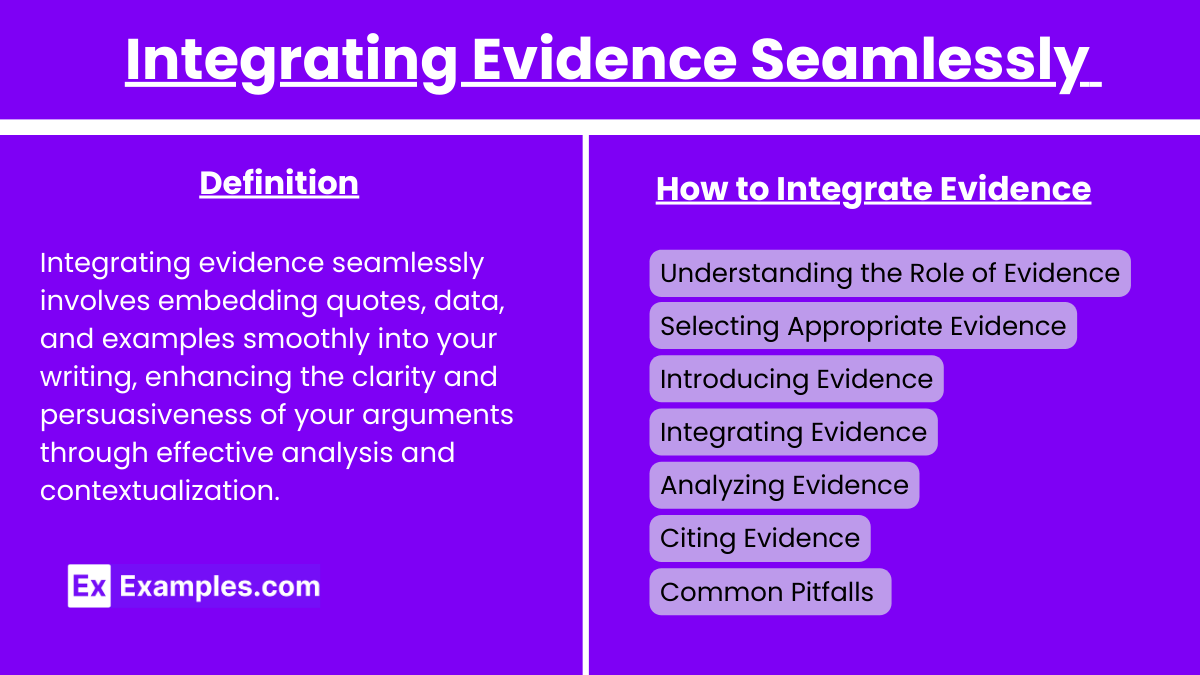Integrating evidence seamlessly is crucial for crafting compelling arguments and supporting your thesis statement in AP English Language and Composition. This involves embedding quotes, data, and examples into your essay smoothly, enhancing your persuasive communication and analytical abilities. Proper integration of evidence demonstrates critical thinking and reinforces the validity of your arguments.
Learning objectives
The learning objectives for integrating evidence seamlessly include developing critical thinking skills, enhancing the quality of research essays, crafting technological thesis statements, and improving persuasive communication. Students will learn to effectively incorporate evidence into essays and analytical essays, ensuring their arguments are well-supported and compelling.
Understanding the Role of Evidence
Definition and Importance: Evidence consists of the information, facts, or data used to support arguments, claims, or assertions in writing. In AP English Language, evidence is crucial for supporting your thesis statement and reinforcing your arguments. It adds credibility to your writing and helps to convince your readers by providing concrete support for your claims.
Types of Evidence:
- Quotes: Direct citations from authoritative sources or texts.
- Statistics: Numerical data that provides quantifiable support for your claims.
- Examples: Specific instances or cases that illustrate broader points.
- Anecdotes: Short, personal stories or accounts that support your argument.
- Facts: Verified and indisputable pieces of information.
Selecting Appropriate Evidence
Relevance: Choose evidence that directly supports your thesis statement and is pertinent to your argument. Irrelevant evidence can confuse readers and weaken your argument.
Credibility: Use evidence from reliable and authoritative sources to enhance the legitimacy of your argument. Scholarly articles, reputable news outlets, and expert opinions are typically credible sources.
Diversity: Incorporate a variety of evidence types to provide a comprehensive and multifaceted argument. This can make your argument more robust and convincing.
Introducing Evidence
Signal Phrases: Use signal phrases to introduce evidence, making it clear that you are presenting someone else’s ideas. Examples include “According to,” “As stated by,” and “Research shows that.”
Context: Provide background information about the evidence to help readers understand its significance and relevance to your argument. This sets the stage for the evidence you are presenting and links it to your thesis.
Integrating Evidence
Embedding Quotes: Integrate quotes smoothly into your sentences. Avoid dropping quotes abruptly; instead, weave them into your own writing.
Paraphrasing: Paraphrase evidence when direct quotes are unnecessary. This shows your understanding of the source material and helps maintain your essay’s flow.
Blending Evidence with Analysis: Combine evidence with your analysis to explain its significance. Don’t just present evidence; interpret it and show how it supports your thesis.
Analyzing Evidence
Critical Thinking: Apply critical thinking to interpret and evaluate the evidence. Discuss its implications, reliability, and how it strengthens your argument.
Link to Thesis: Clearly connect each piece of evidence back to your thesis statement. This reinforces the central argument and maintains the essay’s coherence.
Citing Evidence
Proper Citation: Use appropriate citation styles (MLA, APA, etc.) to give credit to original sources. This is essential in maintaining academic integrity in research essays.
In-Text Citations: Include in-text citations for direct quotes, paraphrases, and summaries. This not only avoids plagiarism but also allows readers to locate the original sources.
Common Pitfalls
Overloading with Evidence: Avoid overwhelming your essay with too much evidence. Select the most compelling pieces and integrate them thoughtfully.
Ignoring Analysis: Don’t let evidence stand alone without analysis. Always explain its relevance and link it to your thesis.
Misrepresenting Sources: Ensure that you represent sources accurately and do not take quotes out of context. Misrepresentation can undermine your credibility and weaken your argument.
By understanding and applying these principles, you can integrate evidence seamlessly into your writing, enhancing your ability to craft compelling, well-supported arguments in AP English Language and Composition. This skill is vital for effective persuasive communication and developing strong analytical essays and research essays. Whether you are addressing a technological thesis statement or any other topic, these techniques will ensure your writing is clear, persuasive, and authoritative


